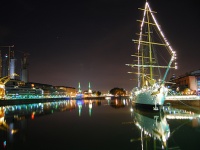 Buenos Aires OverviewDowntown Buenos Aires is as sophisticated as any European city,
with its wide avenues, fine colonial architecture and rows of
pavement cafes. The city was built by French, Italian and Spanish
immigrants and the Porteños (locals) still regard themselves as
more European than South American. Travellers walking through the
leafy parks and boulevards could be forgiven for thinking they were
in Madrid, Paris or Milan. Buenos Aires was founded on the shores of the Rio de la Plata in
1570 and was named after the patron saint of sailors for the good
wind or
The city remained a colonial backwater for 200
years while the Spanish concentrated their attentions on wealthier
Peru. During this time Buenos Aires became a thriving centre for
smuggling between South America and Europe. Dissatisfaction with
Spanish economic and political dominance escalated to boiling point
and culminated in the revolution of May 1810 and finally to
independence in 1816. Its history since then has been dogged by
military coups and political mismanagement; the consequences of
which are growing disaffection with the government and widespread
poverty, as is evident in the sprawling shantytowns on the city's
outskirts. This turbulent history has not managed to stifle the indomitable
spirit of the Porteños whose passion, charm and vibrancy have
forged this great city, a place in which the fire of Evita's soul
and the allure of the tango endure. A holiday in Buenos Aires is a
journey of discovering the fire that pervades Argentine culture, in
everything from food and conversation to music, art and dance. |